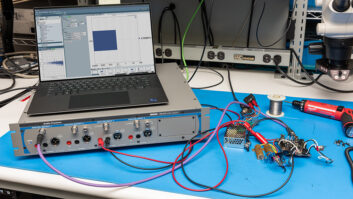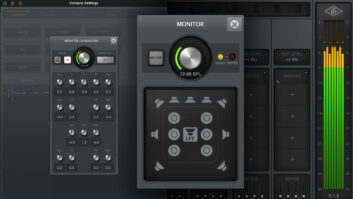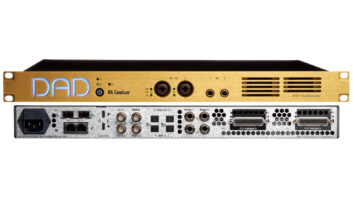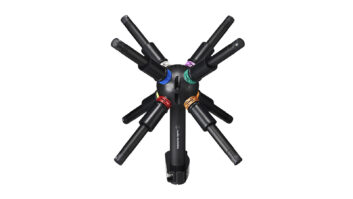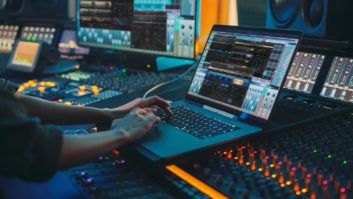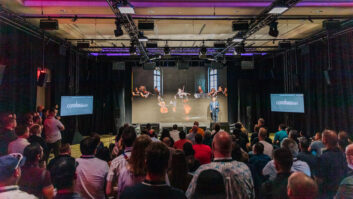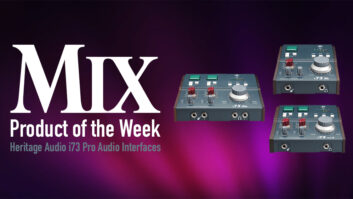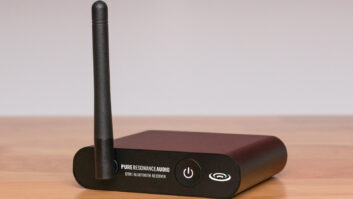Lately, a lot of cost-crashing PC audio hardware and software releases have emerged, not the least of which is Soundscape’s $549 Mixtreme PCI card. Mixtreme is another example of how the computer-based audio price floor is dropping so fast that it seems like some company might be paying us to record and edit with this stuff before too long. And the onboard DSP on the very affordable Mixtreme card is the latest way to adjust compression ratios, resolve clock problems, sync up delay taps and create thick digital mixes, all with a mouse.
MIXTREME AND FRIENDSMixtreme is a multichannel PCI audio card with digital mixing, analog-to-digital conversion and a real-time effects plug-in architecture that works arm-in-arm with Windows-based audio programs to provide a full-service 16-track digital recording environment. For host CPUs overloaded by voracious audio platforms and power-soaking plug-ins, Mixtreme’s dedicated chips are just the ticket for helping even the fastest Pentiums deal with demanding digital audio. Add any of the company’s AD/DA-converter and format-translation boxes (and a growing list of third-party plug-ins) to the mix, and a Mixtreme-based system becomes an expandable multilingual translator between ADAT, TDIF and analog source signals that also happens to take a huge load off the host CPU.
The Mixtreme card comes with Soundscape’s configurable V2 Mixer software and provides 24-bit digital, 16-channel mixing right out of the box. All channel architecture, plug-in configurations and signal routing are user-definable, allowing channel strips to be built one at a time or recalled from a good set of included mixer templates. Users can have as many as 64 channels with EQs, plug-ins and multiple routings up at a time, and each of Mixtreme’s 16 buses can route internal or external I/O to any of the internal tracks. In the dawn of the 96kHz format, the Mixtreme maxes out at 48 kHz. But even without the high-octane, the card sounds great for any application not requiring the extra bandwidth. Several multiband parametric EQs come as standard equipment, and the company’s optional Audio Toolbox ($325) adds a compressor, gate, expander, limiter, delay and chorus/flanger to Mixtreme’s shiny new plug-in tool belt. A growing list of third-party plug-in developers supporting Mixtreme include TC Works’ TC Reverb ($599) and TC Dynamizer ($699), plus a reverb plug-in module from Wave Mechanics ($349), and more may come soon.
Part two of a Soundscape system can include the SS8IO-1 ($1,695), a two-rackspace, 8-channel balanced XLR AD/DA audio interface with bidirectional TDIF port, ADAT Lightpipe in/out ports, programmable routing, front-panel presets and large LED meters. The unit’s +4dB operation can be changed to -10dB levels via internal jumpers. Used as a stand-alone unit, the SS8IO-1 can provide format conversion for TDIF and ADAT signals when connected via clock with DA-88s, ADATs and other digital machines, or it can be used to add more channels to TDIF-savvy digital mixing consoles. Both Word Clock- and Super Clock-based digital equipment can be sychronized, and Soundscape SSHRD-1 DAW owners can upgrade their systems simply by connecting them via TDIF.
For integrating ADAT tracks, Soundscape’s SS8IO-2 ($349) is a half-rack unit sporting the same 8 channels of bidirectional TDIF-to-Lightpipe conversion and Word/Super Clock connectors found in part of its bigger brother, the SS8IO-1. The IO-2’s simple front panel has a power switch, 44.1 and 48kHz sample rate settings, selector buttons between TDIF/ADAT and internal/external clock sources, and the back panel houses TDIF port, Word/Super Clock and Lightpipe I/O connectors. Slightly more expensive is the IO-2’s TDIF-to-analog interface partner, the SS8IO-3 ($599), which also provides sample rate and clock settings, Word/Super Clock and TDIF connectors. The 8-channel IO-3 has -30 and +3dB single-stage peak indicator LEDs per channel and eight pairs of gold-plated RCA connectors on the back panel. On the first SS8IO-3 we tested, the outputs on channels 3 and 4 were mono summed and had a slight flange-like sound, but a replacement unit performed flawlessly.
GETTING STARTEDThe Mixtreme card supports Windows 95, 98 and NT 4.0 and needs at least a Pentium, 16 MB of RAM and a free PCI slot, though once it’s up and running, the card takes over effects-processing chores and frees up the host computer to do a better job of running everything else. Platform support is wide, including Steinberg, Emagic, Cakewalk, Minnetonka and Sonic Foundry, and the future looks expandable, with new plug-in developers onboard and Soundscape’s own S/PDIF and video sync board add-ons available.
Installing and launching the Mixtreme main window is easy enough, and mic and line signals from the connected SS8IO-1 and SS8IO-3 boxes are recognized and routed automatically in the software via the provided 25-pin TDIF cable. Lively, latency-free onscreen signal meters respond to each input level change and to the most subtle mouse fader moves, a welcome relief compared to using Cubase’s latency-prone controls running on the same Pentium PC system. Real-time reverb algorithms can eat up to 40% of total DSP power alone, so Mixtreme’s dedicated processing capabilities have good system-wide benefits while providing “faster” reverbs.
Version 1.0’s software crashed when launching Steinberg Cubase VST/24 and would not work in tandem with it, but after I installed the free 1.04 update, the two apps shared Windows system resources without fighting over IRQs and worked smoothly. Short of tendering the platform debate fires here, “plug and pray” still hounds even the best Windows audio hardware and software, though in all fairness, Soundscape and others like them provide a very stable ride once up and running beyond all the IRQ slot conflicts, BIOS settings and VGA incompatibilities.
Soundscape automatically installs a Windows Soundscape ASIO Driver into Cubase’s ASIO device chooser, and a Cubase song file setup automatically loads and configures 16 VST tracks and Master/Monitor routing directly to the Mixtreme card via track inserts 1-16. Recording with and using Cubase 3.55 on the same machine as Mixtreme sped up noticeably, with screens responding faster and faders feeling less sluggish when not having to process the rich selection of VST plug-ins. The standard multimedia driver in Cubase can only get down to 700 ms of latency, which to me is an unacceptable delay of sound, fader and level response, but with Mixtreme, I was able to trim the host system’s buffer size enough to get as low as 50 ms latency on a 200MHz PC, very livable. There’s no MIDI driver currently ready for Mixtreme, though a free downloadable upgrade is planned.
Mixtreme’s packaging and documentation is a poorly designed combination of bad Styrofoam, multilingual labeling and sparse manuals with missing pages. The SS8IO-1’s manual is a large three-ring binder that dwarfs the 15 single-sided pages it holds, and though the longer Mixtreme manual goes into depth with each feature, it’s a confusing melange of typefaces, typos and a frustrating page-numbering system that repeats itself every few pages. Maybe the easy-to-use yet powerful software speaks enough for itself, but Mixtreme’s underwhelming documentation and packaging need more work to better match what’s inside.
V2 MIXERUnlike Yamaha’s DSP Factory multichannel PC audio card, which defers its software frontend to the recording/MIDI programs that support it, the Mixtreme card comes with a well-designed mixer interface that lets users either roll their own channel strips or choose from a library of presets right off the shelf. With the V2 Mixer software, channels can be individually configured as mono, mono in/stereo out, stereo/mono out or true stereo, and each saved mix can include up to 64 channels, depending on CPU speed limits. An easy-going gray interface surface, colorful track assigns and clear signal level meters per track are easy on the eyes for long sessions, and the built-in EQ modules provide some good ways to mouse around with equalization. Though I prefer the more precise on-curve mouse dragging capabilities found in EQ plug-ins like Waves’ Renaissance EQ, Mixtreme’s interface nonetheless provides intuitive ways to work with EQ curves and provide good-sounding and savable results.
Mixtreme’s default channel strips have room enough for a comfortably sized main fader; horizontal pre-fade peak meter; fader, solo and fade group buttons; pan and I/O assignment pull-down menus; 2-band EQ; plus a couple of plug-ins, a channel sample delay line and more without having to scroll up and down to “reach” it all. A standard 15-inch PC monitor displays 12 channel strips and group and master stereo out strips at average screen resolutions without scrolling, and moving back and forth constantly between them all is easy when mixes go deep. Up to 99 fader groups and 99 solo groups are selectable from each mixer channel surface, and a host of nice touches show up throughout the program. Right-dragging the mouse fades selected channel faders without losing relative positions, and I appreciate that Mixtreme works in the background when running with other programs. This makes screen redraws, and response to them, go faster while putting off Mixtreme’s CPU needs temporarily. The manual, though flawed, does provide a thorough tutorial on building tracks from scratch in Mixtreme, an intuitive process that allows custom strips to be created with an eye on individual system demands and personal preferences without cluttering the desktop.
A PLUG FOR DA PLUG-INSThough currently only sporting onboard EQs, an optional add-on suite (Audio Toolbox, $325) and a sparse five third-party offerings to choose from as of this writing, the Soundscape dedicated plug-in architecture looks promising. Soundscape’s SSHDR1-Plus workstation plug-ins will work with Mixtreme, and Dolby is shipping a $550 surround plug-in for Mixtreme, Aphex’s Aural Exciter III plug-in is on the way, and another company is expected to come out with de-esser, denoiser and other Mixtreme plug-ins in the near future. Stay tuned.
If you like lots of onscreen faders, there are plenty of them in Soundscape’s plug-in modules; virtually each control is a vertical fader. I prefer the more touchy-feely, intuitive onscreen feel of other PC- and Mac-based audio tools, but the clean simplicity of each of the Mixtreme plug-in controls and good output are useful and precise for shaping sounds in their own right.
Soundscape’s Audio Toolbox limiter has CD mastering and live audio applications and offers brick-wall limiting, and the delay plug-in gives the basic multi-tap mono, stereo and linked modes with a nice onscreen representation of the delay’s signal route. TC’s Dynamizer plug-in addresses mastering needs, and both TC and Wave Mechanics provide high-quality reverb algorithms to work with. As the VST plug-in’s popularity increased Cubase’s market share, perhaps the same will happen with the Mixtreme card, hopefully encouraging developers to take advantage of dedicated effects chips.
MIXTREMEDThe Mixtreme card is $549, or $699 with S/PDIF I/O port card. Other prices include SS8IO-1 Audio Interface ($1,695); SS8IO-2 TDIF-to-ADAT converter ($349); SS8IO-3 TDIF-to-analog converter ($599); and the Soundscape Audio Toolbox Plug-In Pack ($325). Additionally, Soundscape offers the SS8IO-3/Mixtreme Bundle at $999 and a $749 SS8IO-2/Mixtreme Bundle.
Soundscape’s flagship SSHDR-1 workstation is in many post, recording, film and mixing facilities, and Mixtreme’s price point, power and quality should appeal to these users, as well as to project-based studios. Once installed and fully linked with Cubase, Mixtreme performed well at handling the lion’s share of effects-processing, signal-routing and digital mixing chores, while giving the host CPU a break and providing easy-to-use digital format and clock conversion used with the company’s analog-to-digital conversion units. Soundscape provides good technical service, years of PC audio know-how and, aside from gripes about PC/Windows, poor documentation and a pair of bad RCA outputs, its Mixtreme- and SS8IO-based studio is an expanding platform that’s well worth the visit.
Soundscape Digital Technology Inc., 4478 Market St., Suite 704, Ventura, CA 93003; 805/658-7375; fax 805/658-6395; www.soundscape-digital.com.
